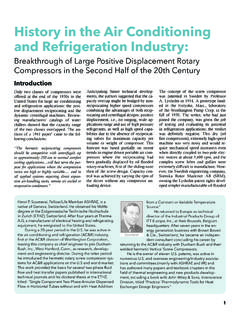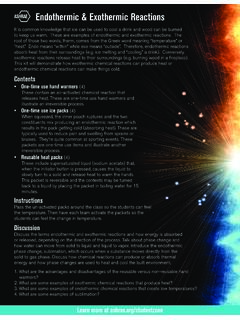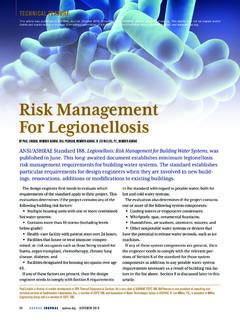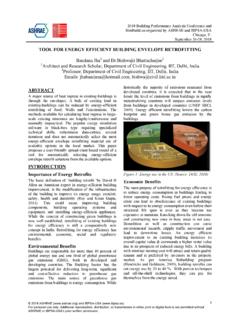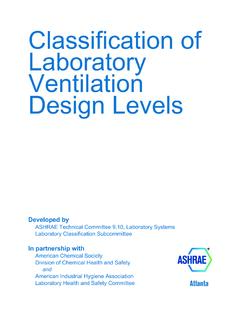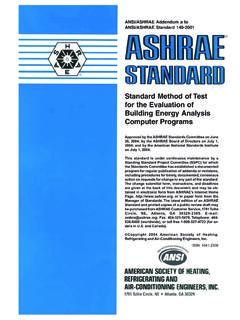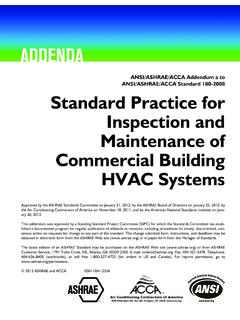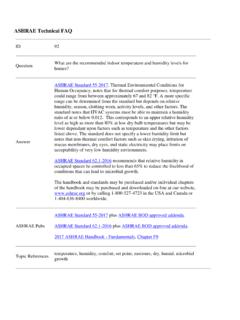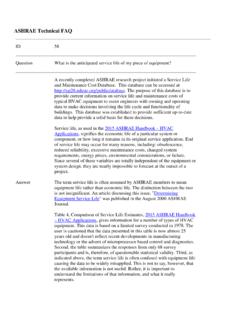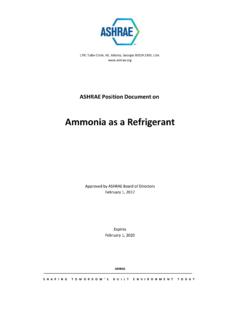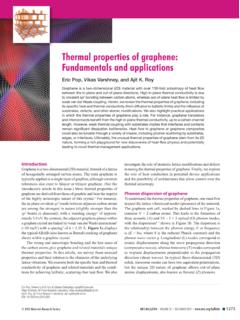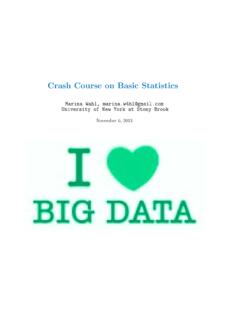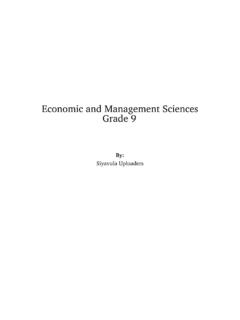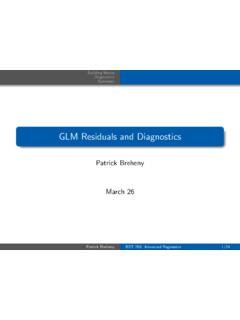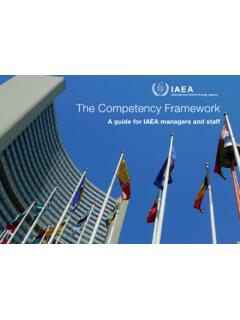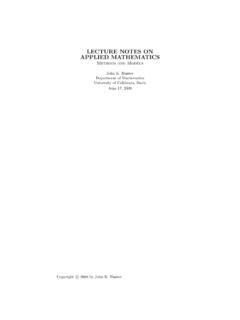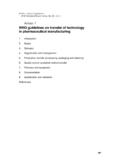Transcription of uidance for uilding perations During the CID- Pandemic
1 ASHRAE JOURNAL MAY 202072 Guidance for Building Operations During the COVID-19 PandemicBY LAWRENCE J. SCHOEN, , FELLOW/LIFE MEMBER ASHRAEThe HVAC systems in most non-medical buildings play only a small role in infectious disease transmission, including Knowledge is emerging about COVID-19, the virus that causes it (SARS-CoV-2), and how the disease spreads. Reasonable, but not certain, inferences about spread can be drawn from the SARS outbreak in 2003 (a virus genetically similar to SARS-CoV-2) and, to a lesser extent, from transmission of other viruses. Preliminary research has been recently released, due to the urgent need for information, but it is likely to take years to reach scientific in the face of incomplete knowledge, it is critically important for all of us, especially those of us in positions of authority and influence, to exercise our collective responsibility to communicate and reinforce how per-sonal choices about social distancing and hygiene affect the spread of this disease and its impact not just on our-selves, but on our societal systems and economy.
2 The con-sequences of overwhelming the capacity of our health-care systems are enormous and potentially tragic. The sooner we flatten the curve, 2 the sooner we can return to safer and normal economic and personal to the WHO (World Health Organization), The COVID-19 virus spreads primarily through droplets of saliva or discharge from the nose when an infected person coughs or Talking and breathing can also release droplets and Droplets generally fall to the ground or other surfaces in about 1 m (3 ft), while particles (aka aerosols), behave more like a gas and can travel through the air for longer distances, where they can transmit to people and also settle on surfaces. The virus can be picked up by hands that touch contaminated surfaces (called fomite transmission) or be re-entrained into the air when disturbed on infected people over long distances in 2003,4 SARS-CoV-2 has been detected as an aerosol in hospi-tals,5 and there is evidence that at least some strains of it remain suspended and infectious for 3 hours,6 sug-gesting the possibility of aerosol transmission.
3 However, other mechanisms of virus dissemination are likely to be more significant, namely, direct person to person contact indirect contact through inanimate objects like doorknobs through the hands to mucous membranes such as those in the nose, mouth and eyesLawrence J. Schoen, , is president and principal engineer at Schoen Engineering, Inc., in Columbia, Md. He was chair of the committee that wrote the most recent ver-sion of the ASHRAE Position Document on Airborne Infectious Diseases. COLUMNIEQ APPLICATIONSIEQ APPLICATIONSThis article was published in ASHRAE Journal, May 2020. Copyright 2020 ASHRAE. Posted at This article may not be copied and/or distributed electronically or in paper form without permission of ASHRAE. For more information about ASHRAE Journal, visit peer-reviewed column does not represent official ASHRAE guidance. For more information on ASHRAE resources on COVID-19, visit 2020 ASHRAE JOURNAL73 droplets and possibly particles spread between people in close proximity.
4 For this reason, basic principles of social distancing (1 to 2 m or 3 to ft), surface cleaning and disinfection, handwashing and other strategies of good hygiene are far more important than anything related to the HVAC In the middle-Atlantic region of the United States where I work, malls, museums, theaters, gyms and other places where groups of people gather are closed and there are stay at home 8 orders. This is a game of chance, and the fewer individuals who come in close contact with each other, the lower the prob-ability for spread of the disease. Since symptoms do not become apparent for days or weeks, each of us must behave as though we are public buildings, considered essential to varying degrees, remain open. These include food, hardware and drug stores, and of course, hospital and health-care facilities (which are beyond the scope of this article). Anecdotally, some universities are allowing some or all faculty, staff and graduate students to conduct essential research and online classes.
5 Banks and other service organizations are open to staff and are receiving custom-ers by appointment only, and private and government workplaces are open with work at home for some or all encouraged or those buildings that remain open, in addition to the policies described above, non-HVAC actions include: Increase disinfection of frequently touched Install more hand sanitation dispensers, assuming they can be procured. Supervise or shut down food preparation and warming areas, including the office pantry and coffee station. Close or post warning signs at water fountains in favor of bottle filling stations and sinks, or even better, encourage employees to bring their water from the basics above are covered, a few actions related to HVAC systems are suggested, in case some spread of the virus can be affected: Increase outdoor air ventilation (use caution in highly polluted areas); with a lower population in the building, this increases the effective dilution ventilation per person.
6 Disable demand-controlled ventilation (DCV). Further open minimum outdoor air dampers, as high as 100%, thus eliminating recirculation (in the mild weather season, this need not affect thermal comfort or humidity, but clearly becomes more difficult in extreme weather). Improve central10 air filtration to the MERV-1311 or the highest compatible with the filter rack, and seal edges of the filter12 to limit bypass. Keep systems running longer hours, if possible 24/7, to enhance the two actions above. Consider portable room air cleaners with HEPA filters. Consider UVGI (ultraviolet germicidal irradiation), protecting occupants from radiation,13 particularly in high-risk spaces such as waiting rooms, prisons and sites present unique challenges. Much, but not all, construction work has the recommended social distancing; much, but not all, is outdoors or in partially enclosed and therefore well-ventilated build-ings; and many, but not all, workers already use per-sonal protective equipment such as masks14 and gloves.
7 Governments in some locations have mandated closure of construction sites, while in others work Engineers who perform field observations, commission-ing or special inspections must consider what work can be postponed, performed remotely, or conducted using photographic documentation, and what personal pre-cautions to take when site visitation is you, the reader, are called upon to advise building operators, please use the above general guidance, and be sure to combine it with knowledge of the specific HVAC system type in a building and the purpose and use of the facility. Like all hazards, risk can be reduced but not eliminated, so be sure to communicate the limitations of the HVAC system and our current state of knowledge about the virus and its spread. We all have a role to play to control the spread of this disease. HVAC is part of it and even more significant are social distancing, hygiene and the influence we can have on personal to William P.
8 Bahnfleth, , , Presidential Member/Fellow ASHRAE, Lew Harriman, Fellow ASHRAE, Yuguo Li, , Fellow ASHRAE, Andrew K. Persily, , Fellow ASHRAE, and Pawel Wargocki, , Member ASHRAE for their review of preliminary drafts of this article. Any errors that remain are the author s According to the WHO, COVID-19 is the name given on February 11, 2020 by the ICTV (International Committee on Taxonomy COLUMN IEQ APPLICATIONSASHRAE JOURNAL MAY 202074of Viruses) to the disease caused by SARS-CoV-2, aka the novel coronavirus. Hospitals and health-care facilities are beyond the scope of this article, though many of the same principles apply to NIH Director: We re on an Exponential Curve , The Atlantic, Peter Wehner, March 17, Bischoff 2013. References cited with only a name and date in this article are taken from ASHRAE Position Document on Airborne Infectious Diseases, 2014, 2020 ( PD ). According to the PD, there is no exact size demarcation between droplets and particles, and this.
9 Is less important than knowing that large droplets and small particles this Columnbehave differently and that the latter can remain airborne. 4. Yu et al. 2004; Li et al. 2005a, 2005b. References from ASHRAE Position Document on Airborne Infectious Aerodynamic Characteristics and RNA Concentration of SARS-CoV-2 Aerosol in Wuhan Hospitals During COVID-19 Outbreak, non-peer reviewed preprint. bioRxiv, posted March 10, Aerosol and Surface Stability of SARS-CoV-2 as Compared with SARS-CoV-1, letter to the editor New England Journal of Medicine, March 17, 2020, DOI: Non-health care workplaces fall into the medium and lower exposure risk categories described in Guidance on Preparing Workplaces for COVID-19, Department of Labor, Occupational Safety and Health Administration OSHA 3990-03 Stay at home orders have been incorrectly called shelter in place. The latter is a more extreme action advised when there is an outdoor contaminant, which is not the COVID-19 situation.
10 See To paraphrase the words of the singer-songwriter Joe Jencks, janitors, cleaners, nurses, aides, doctors, EMTs and other first responders are our viral firefighters, the advance guard in the fight against this This applies to systems that deliver air to the occupied space and, to a lesser extent, room air returned to rotary heat exchangers, in order to reduce cross MERV-13 is approximately equivalent to F7, a rating used in the EU. More effective filters with reasonable pressure drop are available, and some increased pressure drop often results in an acceptably small effect on system Consider the filters contaminated, protect personnel changing them, and seal them in plastic bags for There is research that shows UVGI in both the upper-room and in-duct configurations can inactivate some disease-transmitting organisms. Either of these takes time to plan and install. For more information, see the ASHRAE PD previously cited and Chapter 62 Ultraviolet Air and Surface Treatment of 2019 ASHRAE Handbook HVAC N95 masks are in short supply and some contractors are donating them to medical facilities, according to Engineering News Record March 18, 2020 Construction Firms Respond to Mask Donation Need.
